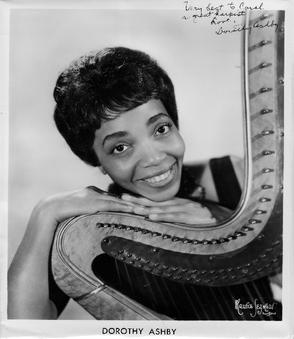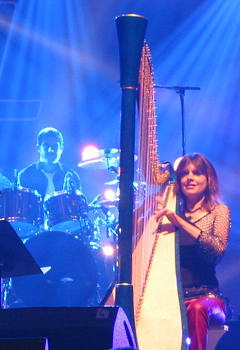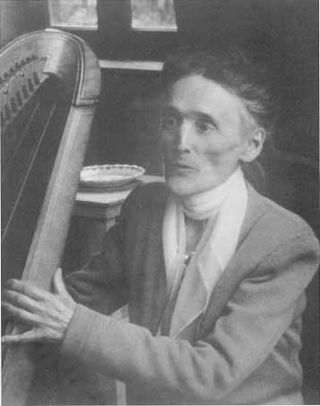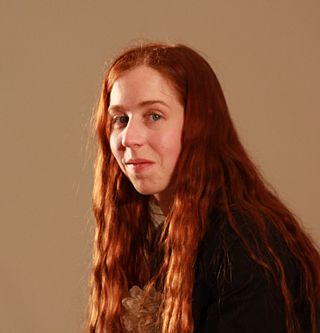Related Research Articles

The harp is a stringed musical instrument that has individual strings running at an angle to its soundboard; the strings are plucked with the fingers. Harps can be made and played in various ways, standing or sitting, and in orchestras or concerts. Its most common form is triangular in shape and made of wood. Some have multiple rows of strings and pedal attachments.

Dorothy Jeanne Thompson, better known as Dorothy Ashby, was an American jazz harpist, singer and composer. Hailed as one of the most "unjustly under loved jazz greats of the 1950s" and the "most accomplished modern jazz harpist," Ashby established the harp as an improvising jazz instrument, beyond earlier use as a novelty or background orchestral instrument, proving the harp could play bebop as adeptly as the instruments commonly associated with jazz, such as the saxophone or piano.

The konghou is a Chinese plucked string instrument. In ancient China, the term konghou came to refer to three different musical instruments: a zither and two different types of harp.
Ushio Torikai is a Japanese composer of contemporary classical music. She is known for her highly individual musical voice, developed over many years of research and compositional experience in diverse musical fields including European classical music, traditional Japanese music, ancient Japanese music and computer/electronics.

Catrin Ana Finch is a Welsh harpist, arranger and composer. She was the Official Harpist to the Prince of Wales from 2000 to 2004 and is visiting professor at the Royal Welsh College of Music & Drama and the Royal Academy of Music in London. Finch has given recitals at venues throughout the world.
Ann Hobson Pilot is an American musician and the former principal harpist of the Boston Symphony Orchestra and the Boston Pops. She has performed with the National Symphony Orchestra, the Pittsburgh Symphony, and as a soloist with many orchestras in the United States. She was one of four African American musicians who were the first to play in United States symphony orchestras during the 1960s.

Henriette Renié was a French harpist and composer who is known for her many original compositions and transcriptions, as well as codifying a method for harp that is still used today. She was a musical prodigy who excelled in harp performance from a young age, advancing through her training rapidly and receiving several prestigious awards in her youth. She was an exceptional instructor and contributed to the success of many students. She gained prominence as a woman in an era where fame was socially unacceptable for women. Her devotion to her religion, her family, her students, and her music has continued to influence and inspire musicians for decades.
Cormac de Barra is a harpist, singer and television presenter and is part of the Moya Brennan Band.
Sylvia Woods is an American harpist and composer, and is perhaps best known for her role in the worldwide renaissance of the Celtic harp, or cláirseach. Woods began selling and writing music for Celtic harps in the 1970s, when the instrument was not widely known in the United States, contributing to a groundswell of interest in the Celtic harp and music. Woods was named one of the “most influential harp forces of the twentieth century” by HarpColumn magazine.
Yolanda Kondonassis is an American classical harpist. She is considered one of the world's premier solo harpists and is widely regarded as today's most recorded classical harpist.
Siobhán Owen is a soprano and harpist from Adelaide, South Australia. Owen regularly performs at festivals, concerts and events around Australia and further abroad. She favours classical and Celtic/folk songs, but also sings pop and jazz on occasion.

Cécile Corbel is a French and Breton singer, harpist, and composer. She has released five albums of original music and worked for Studio Ghibli as a composer for its 2010 film, The Borrower Arrietty. Corbel sings in many languages including French, Italian, Breton, and English and has done songs in Spanish, German, Japanese, Irish, and Turkish. Her lifelong partner is songwriter Simon Caby, who is also her co-composer.

Anna Maria Mendieta is a professional harpist from the United States. She is best known for pioneering the harp as a contemporary tango instrument. She is an orchestral musician and a teacher.
Stephanie Bennett is a harpist, composer, arranger and vocalist who lives in Los Angeles. She plays popular music, jazz, and other contemporary music genres.

Elaine Christy is an American harpist. She has performed at high-profile concert halls including Steinway Hall, Carnegie's Weill Hall, and with the CBS Orchestra on the television show Late Show with David Letterman. In 2012, she is an instructor of harp at Princeton University.
Tara McNeill is an Irish violinist, harpist, and soprano singer from Antrim, Northern Ireland.
Florence Sitruk is a harpist, professor of harp and music teacher of French and German ancestry.

Mildred Dilling was an American harpist. She studied under Henriette Renié in Paris. She first started performing in 1911, and traveled over 30,000 miles (48,000 km) per year at her busiest. She performed with many notable vocalists, had her own weekly NBC radio show, and appeared on the Bing Crosby radio show. She toured Europe and Asia multiple times, and often performed internationally. She enthusiastically championed the harp and gave many celebrities their first harp lesson, including Harpo Marx. In 1962 she helped found the American Harp Society. She devised a lever system for a non-pedal harp that made it more portable than a pedal harp but which allowed flexibility in harp tuning. Her extensive harp collection is held partially by Indiana University, and harp students still use two of her harp music compilations.

Maud Morgan was an American harpist who had a long and distinguished career spanning over 60 years. She was one of the pioneering solo harpists on the American concert stage, and ranked among the most famous and influential harpists in history. She is considered the first American to perform as a solo harpist on the American concert stage.
References
- Gallafent, Alex. "Harpist Tomoko Sugawara." Public Radio International's The World, May 3, 2010.
- ↑ "Tomoko Sugawara". Independent Music Awards. 2011-02-22. Retrieved 2021-08-14.
- ↑ "Tomoko Sugawara | Center for Remembering and Sharing". Archived from the original on 2012-03-30. Retrieved 2011-08-17.